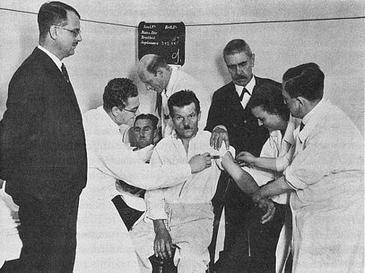
General paresis: Short for "general paresis of the insane." General paresis is the tertiary stage of neurosyphillis, which was the most prevalent mental disorder of the late 19th century, accounting for up to 10% of all asylum inmates. The symptoms of general paresis include psychosis, dementia, paralysis, and, at that time, inevitable death. In 1917, Austrian psychiatrist Julius Wagner-Jauregg injected the blood of a soldier infected with malaria into nine patients with general paresis. One died, two were sent to asylums, and six showed significant improvement (although four of these later relapsed). Of the 200 patients who first received this "fever-treatment," 50 eventually improved. For this pioneering work with severely ill patients previously thought to be beyond hope, Wagner-Jauregg was awarded the Nobel Prize in Physiology or Medicine in 1927, one of only three psychiatrists to receive that honor. Flushed with this success, biological psychiatrists happily set off to discover somatic treatments for other mental illnesses. Unfortunately, because schizophrenia and other psychiatric disorders do not have any simple, identifiable organic cause (such as the bacterial infection that causes neurosyphillis), no more miraculous treatments have been discovered. The advent of penicillin, which made malarial treatment obsolete, as well as Dr. Wagner-Jauregg's late-life admiration for the Nazi Party (he applied twice for membership), have caused him to become a generally forgotten figure in the history of medicine.
No comments:
Post a Comment
Note: Only a member of this blog may post a comment.